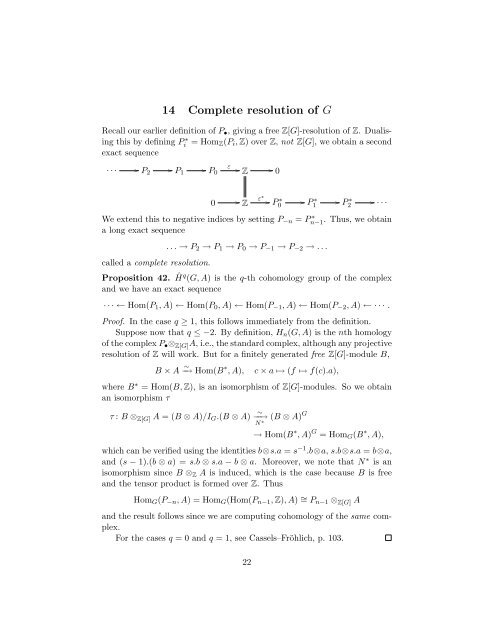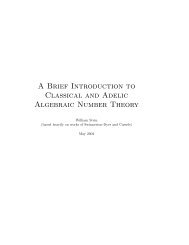A Short Course on Galois Cohomology - William Stein - University of ...
A Short Course on Galois Cohomology - William Stein - University of ...
A Short Course on Galois Cohomology - William Stein - University of ...
You also want an ePaper? Increase the reach of your titles
YUMPU automatically turns print PDFs into web optimized ePapers that Google loves.
14 Complete resoluti<strong>on</strong> <strong>of</strong> G<br />
Recall our earlier definiti<strong>on</strong> <strong>of</strong> P•, giving a free Z[G]-resoluti<strong>on</strong> <strong>of</strong> Z. Dualising<br />
this by defining P ∗<br />
i = HomZ(Pi, Z) over Z, not Z[G], we obtain a sec<strong>on</strong>d<br />
exact sequence<br />
· · ·<br />
<br />
P2<br />
<br />
P1<br />
<br />
P0<br />
0<br />
ε <br />
Z<br />
<br />
0<br />
<br />
ε<br />
Z ∗ <br />
P ∗ 0<br />
<br />
P ∗ 1<br />
<br />
P ∗ 2<br />
<br />
· · ·<br />
We extend this to negative indices by setting P−n = P ∗ n−1 . Thus, we obtain<br />
a l<strong>on</strong>g exact sequence<br />
called a complete resoluti<strong>on</strong>.<br />
. . . → P2 → P1 → P0 → P−1 → P−2 → . . .<br />
Propositi<strong>on</strong> 42. ˆ H q (G, A) is the q-th cohomology group <strong>of</strong> the complex<br />
and we have an exact sequence<br />
· · · ← Hom(P1, A) ← Hom(P0, A) ← Hom(P−1, A) ← Hom(P−2, A) ← · · · .<br />
Pro<strong>of</strong>. In the case q ≥ 1, this follows immediately from the definiti<strong>on</strong>.<br />
Suppose now that q ≤ −2. By definiti<strong>on</strong>, Hn(G, A) is the nth homology<br />
<strong>of</strong> the complex P•⊗ Z[G]A, i.e., the standard complex, although any projective<br />
resoluti<strong>on</strong> <strong>of</strong> Z will work. But for a finitely generated free Z[G]-module B,<br />
B × A ∼ −→ Hom(B ∗ , A), c × a ↦→ (f ↦→ f(c).a),<br />
where B ∗ = Hom(B, Z), is an isomorphism <strong>of</strong> Z[G]-modules. So we obtain<br />
an isomorphism τ<br />
τ : B ⊗Z[G] A = (B ⊗ A)/IG.(B ⊗ A) ∼<br />
−−→ (B ⊗ A)G<br />
N ∗<br />
→ Hom(B ∗ , A) G = HomG(B ∗ , A),<br />
which can be verified using the identities b⊗s.a = s −1 .b⊗a, s.b⊗s.a = b⊗a,<br />
and (s − 1).(b ⊗ a) = s.b ⊗ s.a − b ⊗ a. Moreover, we note that N ∗ is an<br />
isomorphism since B ⊗Z A is induced, which is the case because B is free<br />
and the tensor product is formed over Z. Thus<br />
HomG(P−n, A) = HomG(Hom(Pn−1, Z), A) ∼ = Pn−1 ⊗ Z[G] A<br />
and the result follows since we are computing cohomology <strong>of</strong> the same complex.<br />
For the cases q = 0 and q = 1, see Cassels–Fröhlich, p. 103.<br />
22
















